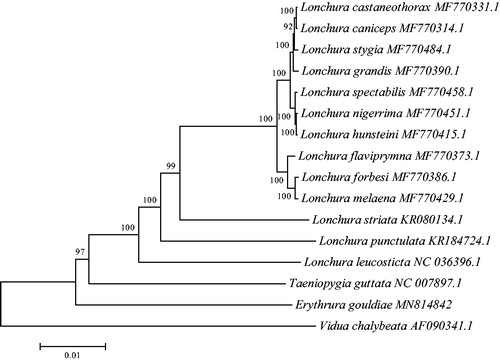Abstract
In this paper, we reported the complete mitogenome of Erythrura gouldiae. E. gouldiae mitogenome is 16,830bp base pairs long. The overall base compositions of complete mitogenomes of E. gouldiae is 30.87% A, 22.77% T, 32.07% C, 14.28% G. All genes exhibit the typical mitochondrial gene arrangement and transcribing directions. The phylogenetic analysis based on 15 mitochondrial sequence data suggested that E. gouldiae are closely related to the same family specie Taeniopygia guttata. The results obtained here would be useful for the conservation and phylogeny of E. gouldiae.
Erythrura gouldiae, also known as Gouldian Finch, belonging to the family Estrildidae (Aves, Passeriformes). It is a beautiful bird native to northern Australia (IUCN Citation2016), mainly inhabits grassland, shrubland and savanna. It lives in open, tropical woodland with a grassy understorey, nesting almost exclusively in tree-hollows. (O’Malley Citation2006; IUCN Citation2016). It wearing colorful feathers, lively and agile, is widely likes as pet birds. E. gouldiae is raised and breed by birds lovers of many countries and regions, E. gouldiae wearing bright and colorful feathers, lively and agile, and easy to breed, lots of E. gouldiae were caught and bred in captivity as pet. Due to a large number of hunting and invasion by human activities, E. gouldiae have become very rare in Australia. (Collar and Butchart Citation2014; IUCN Citation2016).
Whole blood sample was collected from one individual of E. gouldiae, which was bred in the Nanjing bird market (N31°85′, E118°70′), Jiangsu province, China. Genomic DNA was isolated using the DNAiso reagent (Takara, Beijing, China) and was stored in the Forest Police Forensic Center of State Forest Administration (Accession S2020J1101201). A set of universal primers were designed for polymerase chain reaction amplification, and Sanger sequencing was performed to obtain genome information.
The complete mitochondrial genome (GenBank accession: MN814842) of E. gouldiae is a typical circular DNA molecule with 16,720bp in length. The nucleotide composition of the genome is 30.87% A, 22.77% T, 32.07% C, 14.28% G, with C + G content of 46.35%. Mitochondrial genome of E. gouldiae was composed with 13 protein-coding genes, 22 transfer RNA genes, 2 ribosomal RNA genes, and a non-coding control region. The gene arrangement and transcribing directions in the mitochondrial genome of E. gouldiae is identical to other birds of Passeriformes (Liu et al. Citation2019; Xu et al. Citation2019).
Phylogenetic analysis of E. gouldiae was performed based on the complete mitogenome of 15 species of Estrildidae. Sequence dataset were aligned using ClustalX and Neighbour-Joining (NJ) analysis was conducted using MEGA 7.0, with 1000 bootstrap replicates (Kumar et al. Citation2016). The phylogenetic NJ tree showed that the mitogenome of E. gouldiae was genetically the closest to the Taeniopygia guttata of the same family (). The results obtained here could contribute to future studies on population genetics and biological conservation of Passeriformes birds (Zhang et al. Citation2020).
Disclosure statement
No potential conflict of interest was reported by the author(s).
Additional information
Funding
References
- Collar NJ, Butchart S. 2014. Conservation breeding and avian diversity: chances and challenges. Int Zoo Yb. 48(1):7–28.
- International Union for Conservation of Nature (IUCN). 2016. The IUCN red list of threatened species. Erythrura gouldiae. Brussels, Belgium: IUCN; Version 2019-3. [accessed 2007 Oct 1]. http://www.iucnredlist.org.
- Kumar S, Stecher G, Tamura K. 2016. MEGA7: molecular evolutionary genetics analysis version 7.0 for bigger datasets. Mol Biol Evol. 33(7):1870–1874.
- Liu DW, Sun CH, Fei YL, Hou SL, Tang SZ. 2019. Complete mitochondrial genome of Grey Treepie, Dendrocitta formosae (Aves: Corvidae). Mitochondrial DNA B. 4(2):2326–2327.
- O’Malley C. 2006. National recovery plan for the Gouldian Finch (Erythrura gouldiae). Aust Avicult. 38:237–248.
- Xu N, Zhang QZ, Chen R, Liu HY. 2019. The complete mitogenome of red-collared lorikeet (Trichoglossus rubritorquis) and its phylogenetic analysis. Mitochondrial DNA Part B. 4(2):3116–3117.
- Zhang QZ, Sun CH, Zhu Y, Xu N, Liu HY. 2020. Genetic diversity and structure of the round-tailed paradise fish (Macropodus ocellatus): Implications for population management. Global Ecol Conserv. 21:e00876.

